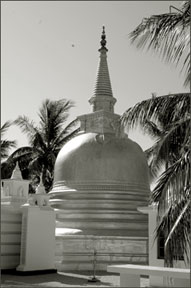The Buddha’s visit to Nagadeepa
By Samangie Wettimuny
[email protected]
New year festivity and splendour were fresh in the air when Sri
Lankan Buddhists celebrated Bak Full Moon Poya day yesterday, the first
Poya after the major cultural event.
|

Buddha’s second visit to Lankadeepa |
The month of Bak is of great significance to us as according to the
historical records the Buddha’s second visit to Sri Lanka had taken
place on such a month about two thousand five hundred and ninety years
ago.
As mentioned in the Mahavamsa, in the fifth year (523 B.C) of Supreme
Enlightenment, the Buddha had visited Nagadeepa in Lankadeepa (Sri
Lanka) in order to settle a dispute between Mahodara and Chulodara
-uncle and nephew who were at war with each other over a gem studded
throne.
While the Buddha was residing at Jethawana he saw in his Divine Eye
the disaster that was about to take place and arrived in Nagadeepa on
Bak Amawaka Poya day (fifteen days prior to Bak Full Moon Poya Day).
Mahodara was then a mighty king in Nagadeepa, a Naga-kingdom in the
ocean that covered five hundred yojanas. His younger sister,
Thirachchika was married to a Naga King of the Vaddhamana mountain.
Chulodara was their son.
At the time of his death Thirachchika’s father gave her one of his
most valuable jewels- a gem-studded throne. Mahodara was unhappy over
this and his anger became intense when the throne was owned by
Thirachchika’s son in the end. He could no longer tolerate this and
decided to declare war against Chulodara, his nephew.
|

Nagadeepa Stupa |
As the Mahavamsa says a Deva named Samiddhi Sumana who dwelt in
Rajayatana tree (a Banyan tree) in Jethawana too had joined the Buddha
during his visit to Nagadeepa.
The Deva in fact had up rooted the tree and had held it like a
parasol over the Buddha! The Buddha had made no objections as he knew
that the god had lived in Nagadeepa in one of his previous births. In an
another birth he had seen Paccekabuddhas taking their meals under the
same Kiripalu tree.
The sight made him happy and he offered them leaves to cleanse their
alms bowls.
The merit was strong enough for him to be born in the same tree in
the Jetawana Garden as a god. The Buddha brought him to Lankadeepa
together with the tree as the Enlightened One knew that the tour will
benefit him immensely.
As the Buddha arrived in Nagadeepa the Nagas were about to declare
war. The Buddha hovered there in mid-air above the venue and in order to
alarm the Nagas called forth dread darkness over the battle-ground.
The Nagas were said to be terrified not knowing what to do. Then the
Buddha had spread light abroad in order to comfort those who were in
distress.
The Nagas were overwhelmed by happiness to see the Buddha who was
hovering in mid-air. They raised their hands and worshipped the
Enlightened One. He then preached to the Nagas in order to make them
understand the evils of hatred.
The Buddha narrated to them Jathaka stories like Karkoluka, Pandana,
Latukika, Wattaka which showed the evils of hatred and the importance of
living in harmony. Chulodara and Mahodara shed their weapons soon and
offered the gem studded throne to the Buddha. The Enlightened one who
was in mid-air then alighted on the earth and sat on the throne.
The Mahavamsa finely describes how the Nagas offered him dhana.
Thousands of Nagas established themselves in the three refuges (Buddha,
Dhamma, Sangha) and in the moral precepts.
Naga king Maniakkhika of Kelaniya who was the uncle of Mahodara
(mother’s brother) too was among the ones who came to participate in the
battle.
In fact Maniakkhika had become established in Buddha, Dhamma and
Sangha (three refuges) and in the moral precepts during the Buddha’s
first visit to Sri Lanka- to Mahiyangana. The Naga –king who was
overwhelmed by the Buddha’s power of compassion thanked him profusely
for settling down the dispute which otherwise would cost millions of
lives.
“The Compassion you showed is great”. He told the Buddha.
“Thatagatha, we would have all been consumed to ashes had not the Buddha
intervened. May your compassion yet light also specially on me”. Thus
Maniakkika slowly revealed his intention of seeing the Buddha visiting
his kingdom in Kelaniya if he intends to visit the country again. The
Buddha remained silent and it indicated that he had accepted the
invitation.
The Naga King then asked for an object of worship and as a result the
Buddha gave over the Rajayathana tree and the gem studded throne to him
to do homage. Historical records state that Maniakkikha planted the
Rajayathana tree on that very spot as a sacred memorial.
“Since the Thathagatha has used these two, paying homage to them will
bring about blessings and happiness” the Buddha had told the Nagas
before returning to Jethawana on the same, Bak Amawaka poya day thus
making the whole month sacred for Buddhists, to celebrate it with much
piety and reverence in later years!
Nagadeepa Stupa which was constructed by Chulodara and Mahodara
stands magnificently even today at Nagadeepa in Jaffna district. |
